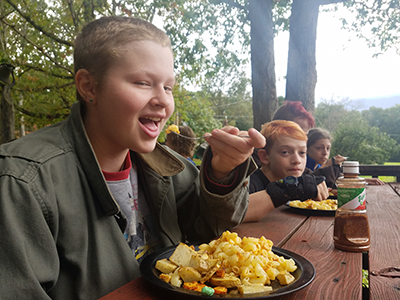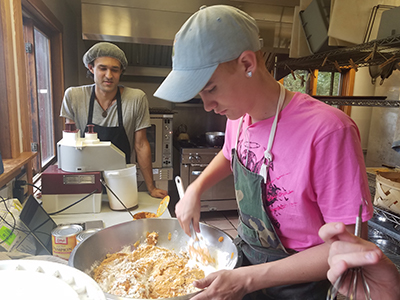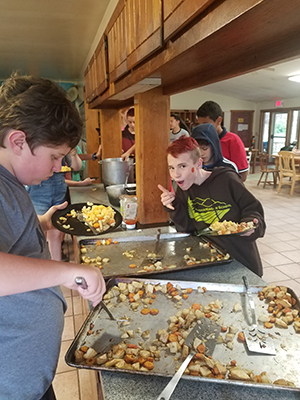Benefits of Healthy School Lunches

In 1946, President Truman stated, “The well-nourished school child is a better student. He is healthier and more alert. He is developing good food habits which will benefit him for the rest of his life.” Although Truman’s message was problematic in his solitary use of male pronouns, his message was right on. The benefits of healthy school lunches are numerous!
This week, schools across the nation are celebrating the National School Lunch Act. This program provided school aged children with balanced, low-cost or free lunches. October is also National Farm to School Month, celebrating food education and the increasing relationship between farms and schools. With all this national attention on food and its role on education, it feels important to share our own experiences.
Arthur Morgan School’s farm is a significant part of our program. We cherish the food we get from it and the opportunities it provides for real life experiences and learning. Today we highlight it’s role in our community and the education of our students.
Good Food means Better Focus
One of the ways AMS is different from a lot of other schools is that we provide our students with freshly prepared snacks and lunches. AMS does not have the traditional cafeteria where students choose from warmed up pizza slices or cheeseburgers. We cook our meals from scratch and serve them family style, meaning we all share the same food. They contain a healthy balance of protein, grain, and vegetables.
Learn More about AMS Boarding School Life
Every meal relies on food from the garden, often cleaned and served within a hour of its harvest. Even in the middle of winter winter, we are able to harvest fresh greens from our greenhouse, retrieve squash or potatoes from storage, or cook up frozen veggies students preserved earlier in the year. As a practice we strive to keep our food as local, fresh and healthy as possible.
As we all eat together, we share our thoughts from classes or current events, stories from the boarding houses, and plans for future events. In this ways, meals are just as much about building community as they are about sustenance.

So Many Learning Opportunities
The AMS farm is a cornucopia of educational possibilities. Kavita Hardy, the Farm and Garden coordinator, offers two internships each year, one in the fall and one in the spring. While preparing the ground each spring, she teaches students to think like chemists, geologists and ecologists to understand how plants get the nutrition they need to grow. Then, the students plant seeds and learn how genetic traits are passed down through each life cycle.
In the fall, classes are more about harvesting. While gathering produce, students learn botany by comparing plants and recognizing their differences. Caring for livestock provides opportunities for students to explore the development of civilization or animal behavior, while harvesting them provides a number of lessons in anatomy. “Through close observation and interaction with the life of food, AMS students experience science and social studies at their most essential purpose,” Hardy explains, “to understand the world around them.”
 The kitchen internship also uses food as a platform for scientific and cultural inquiry. Kitchen interns prepare meals. As they combine their ingredients, they learn about the chemical reactions that occur while cooking and then how those food will chemically interact with their bodies. They also plan menus and make conscious choices about which foods to include to create a balance and nutritious diet. As they do so, they examine the ways locally available foods have impacted history. Through this study, students get a better understanding of the important role food has on our lives both individually and as a community.
The kitchen internship also uses food as a platform for scientific and cultural inquiry. Kitchen interns prepare meals. As they combine their ingredients, they learn about the chemical reactions that occur while cooking and then how those food will chemically interact with their bodies. They also plan menus and make conscious choices about which foods to include to create a balance and nutritious diet. As they do so, they examine the ways locally available foods have impacted history. Through this study, students get a better understanding of the important role food has on our lives both individually and as a community.
Learning Life Skills
Besides nutritious food and engaging lessons, the AMS garden and kitchen also provide students with opportunities to learn real life skills. During Wednesday work projects, AMS students regularly cultivate soil, plant seeds, weed, and harvest. They also help with the daily animal chores of feeding and cleaning up after them. In the kitchen, students wash vegetables, chop ingredients, cook meals, and then clean up after themselves
Through exposure to the farm and kitchen, student understand the immense work that goes into putting food on their plate. They take part in every step of the food cycle from when a seed is planted in the soil to when the uneaten scraps are returned to the compost. Through this work, students gain an appreciation of where their food comes from and just how much effort goes into producing it!
-by Nicholas Maldonado
